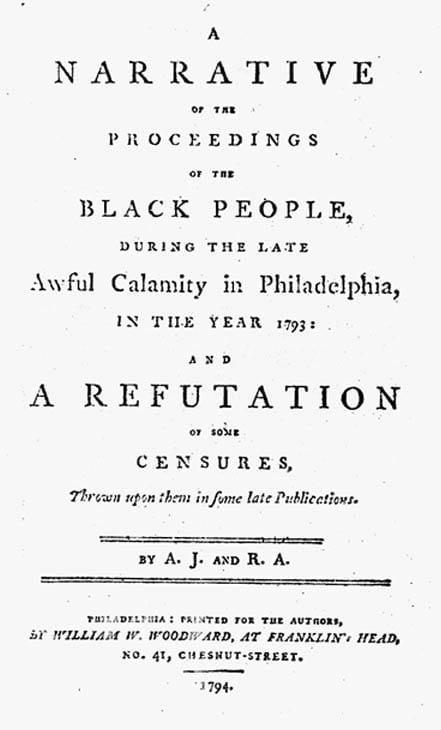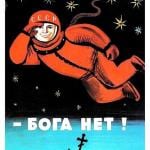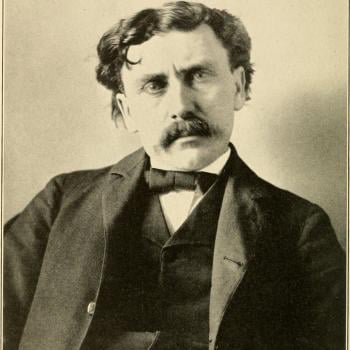Some twenty years ago, I was working on the writer Charles Brockden Brown, the first American to earn a successful living as a novelist. In 1798, he wrote the novel Arthur Mervyn, which has a setting that we today find relevant to the point of shocking. It concerns life in a US city during a dreadful epidemic, and how that experience spurs hideous racial fears and stereotypes. At the same time, that panic also laid an essential foundation for the emergence of organized African-American religious life in the US. I wrote a paper on the whole affair that I won’t reproduce in full, but you can download a pdf here. It’s much more detailed than the bare summary I offer here.
Brown’s book depicts life in Philadelphia during the yellow fever epidemic of 1793, which killed around ten percent of the inhabitants. His account of the city facing epidemic is terrifying. Here is the mass exodus from the city, of fever refugees:
Every farmhouse was filled with supernumerary tenants; fugitives from home, and haunting the skirts of the road, eager to detain every passenger with inquiries after news…. Families of weeping mothers, and dismayed children, attended with a few pieces of indispensable furniture, were carried in vehicles of every form. The parent or husband had perished; and the price of some moveable, or the pittance handed forth by public charity, had been expended to purchase the means of retiring from this theatre of disasters; though uncertain and hopeless of accommodations in the neighboring districts.
There are harrowing accounts of social and family breakdown, as friends and family members refused to have anything to do with anyone who might have been exposed to the disease. As Brown writes,
The city, we were told, was involved in confusion and panic… Magistrates and citizens were flying to the country…. Terror had exterminated all the sentiments of nature. Wives were deserted by husbands, and children by parents. Some had shut themselves in their houses, and debarred themselves from all communication with the rest of mankind. …. The chambers of disease were deserted, and the sick left to die of negligence. None could be found to remove the lifeless bodies. Their remains, suffered to decay by piecemeal, filled the air with deadly exhalations, and added tenfold to the devastation.
By a horrible irony, the disease was actually not contagious. As nobody realized at the time, it was actually spread by mosquitoes.
Within the city itself are scenes of a community of the living dead, in language which borrows from Dante:
The market-place and each side of this magnificent avenue were illuminated, as before, by lamps; but between the verge of Schuylkill and the heart of the city, I met not more than a dozen figures; and these were ghost-like, wrapt in cloaks, from behind which they cast upon me glances of wonder and suspicion; and, as I approached, changed their course, to avoid touching me. Their clothes were sprinkled with vinegar; and their nostrils defended from contagion by some powerful perfume.
The book also has a disturbing racial angle. The city at the time was a very mixed and generally progressive place, and is rightly called the capital of Black America. African-Americans acquitted themselves very well during the crisis, even heroically, as nurses, cart drivers, and gravediggers. Yet despite this, just five years later Brown portrayed a city under racial siege, from a black assault as much as from yellow fever. Black characters are largely absent from the narrative – in total contrast to their prominent role in the whole affair – and when they do appear, they are looters, thieves, grave robbers. Brown was not making up this material himself, but was borrowing from other contemporary white survivors. Those observers charged that blacks had used their opportunity to steal, loot, profiteer, and even kill.
These charges were commemorated in print by the work of Matthew Carey, in his Short Account of the Malignant Fever Lately Prevalent in Philadelphia. Carey records that
The great demand for nurses afforded an opportunity for imposition, which was eagerly seized by some of the vilest of the blacks. They extorted two, three, four, even five dollars a night for attendance, which would have been well paid by a single dollar. Some of them were even detected in plundering the houses of the sick.
Carey acknowledged that such actions were not typical of the black contribution, but the accusations were severe enough.
Black Philadelphia responded furiously. The counter-movement was led by Richard Allen and Absalom Jones, who were among the founders of African-American church life in this country. They wrote the pamphlet A Narrative of the Proceedings of Black People During the Late Awful Calamity in Philadelphia in the Year 1793, and a Refutation of the Censures Thrown Upon Them in Some Late Publications, which has been described as probably the nation’s very first African-American political publication.
The activism also helped create the grass roots religious movement that contributed to founding the AME church, with Richard Allen as its first bishop. Absalom Jones was the first African-American to be ordained a priest in the Episcopal Church. As I argue in the paper, the early 1790s critically redefined America’s racial boundaries and expectations.
That controversy is at the heart of Arthur Mervyn, with its really horrible and (at best) condescending accounts of black actions during the epidemic crisis. In perhaps the most threatening black appearance in the book, Mervyn discovers a looted cabinet, and is knocked aside by the “tawny… apparition” perceived in the mirror, the black thief who had broken into it. Blacks also rob the dead. (See my whole paper for many other examples).
Why is Brown so cool (to say the least) towards blacks? I suggest two main reasons, both of which reflected conditions specific to the early/mid 1790s. The first is clearly his knowledge of Santo Domingo, and the continuing savagery there during the revolution that created the Haitian Republic. Brown knew something of the situation from the refugees in Philadelphia (and in other cities, like New York), and conditions his view of blacks as animalistic primitives. A second factor involves more speculation, but I suggest that we should look closer to home than Santo Domingo, namely at the free black community of Philadelphia itself. The character of the black population in the city was changing rapidly at this time, from the vestigial slave community of the 1780s to the larger, self-confident, and more vocal free body of Richard Allen’s age.
For someone who left Philadelphia in 1793, and returned sporadically through the decade, the changing and expanding role of African-Americans in the city might well have provided a sense of concern and insecurity, even a symptom of urban decay. Racial frontiers are under threat, and Brown, like others of his age, responds predictably, with panic and puzzlement. How exactly should free Blacks be treated? Are they neighbors and Christian brothers? Should they be as deferential as the slaves they or their parents had once been, or should they be treated as equals? Could a decent white man or woman eat with them? Visit them? Sit beside them in church?
The tension and uncertainty arising from all these questions is reflected throughout the pages of Arthur Mervyn.
Please give me a break on one thing. I wrote that paper twenty years ago. A lot of scholarship has appeared since, but I have not sought to update the piece. Among much else by way of more recent scholarship, see
Donald J. McNutt, Urban Revelations: Images Of Ruin In The American City, 1790-1860 (Routledge, 2006).
Ingrid Gessner, Yellow Fever Years: An Epidemiology Of Nineteenth-Century American Literature And Culture (Peter Lang 2016).
Philip Barnard, Hilary Emmett, and Stephen Shapiro, eds., The Oxford Handbook of Charles Brockden Brown (Oxford University Press, 2019).
Just recently, for instance, the Atlantic did this piece on the epidemic.














